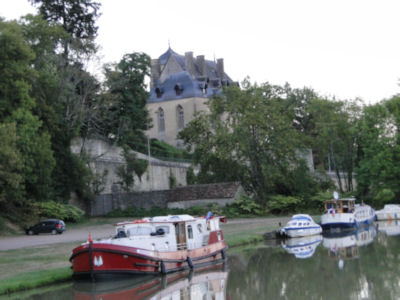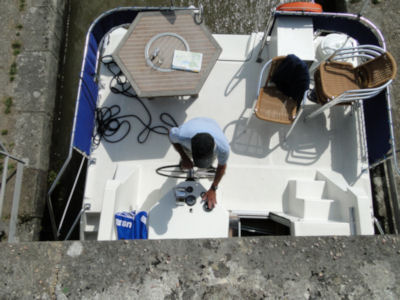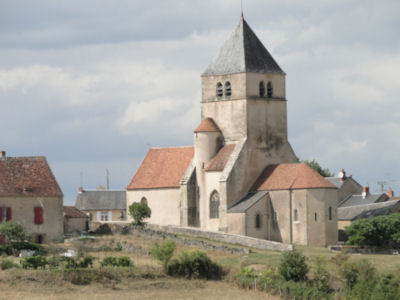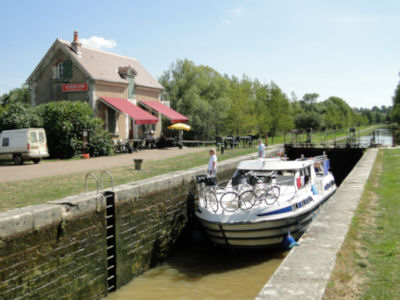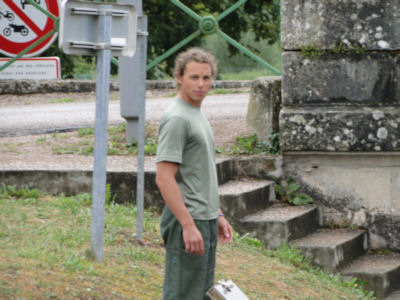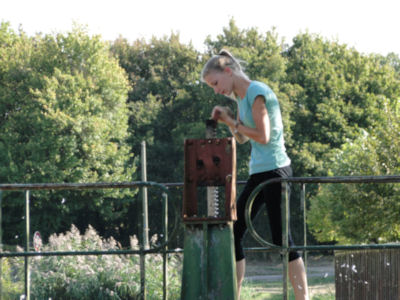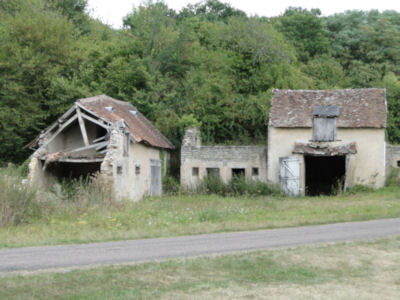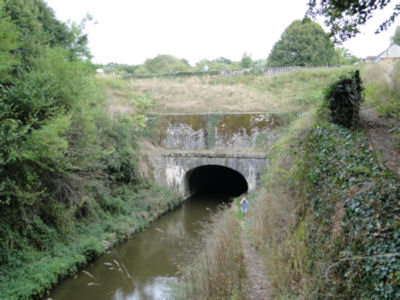We were underway about 9:30 AM Friday morning, having been delayed a bit waiting for the Canalous folks to turn on the water supply when they arrived at 9:00 AM. We learned that they turn the water off when they leave in the evening. Last night was the warmest night we spent on the boat, as our room did not cool down until late into the night. While we are well pleased with our Tarpon 37, we have two complaints that presumably would not be too hard or expensive for Canalous to address.
The first improvement suggestion would be to rework the hanging plastic curtain in the bathrooms so that it can be wrapped completely around the shower section of the bathroom. This would prevent water from running all over the countertop of the vanity. We own a power boat back home and that is how the shower is configured. The second complaint, and this is a more impacting one, is to provide screens for the windows and openings. While the trip has not been too bad from a bug perspective during the day, other than bees and flies when we have food and wine out, the bugs are bad at night if the windows/doors are left open with the lights on.
What we have been doing in the evening is closing off the doors to the bedrooms so that no light shines into the bedrooms, and opening the bedroom windows at the same time. This lets cool air into the bedrooms, presumably without attracting too many bugs. Then we all gather in the main cabin with the windows closed, the A/C on and the lights on. I have been going to bed an hour or two after everyone else, so my routine has been to turn off the A/C, open the windows in the main cabin, then quickly shut off the cabin lights before the bugs figured out they could get in. As long as we keep the lights on for just a bit in the bedroom, we make it through the night with only a few buggy companions. Last night, though, I did get my first mosquito bite on my foot during the night. My foot was sticking out the bottom of the comforter, so it evidently presented a good target. Better that the mosquito is working on my foot than buzzing around my ear, though, as I think that is one of the worst sounds to hear as one is trying to fall asleep. We have managed to avoid a large-scale bug issue, but only by taking evasive action. It would be so much simpler and more comfortable for the boaters if the boats were equipped with screens.
So far on the trip we have had spectacular weather. Other than last Sunday where it was about 70 degrees, every other day has been in the 80′s. Today, though, the weather started turning for the worse late in the afternoon as clouds rolled in from the west. The forecast is calling for 60% chance of precipitation today, 100% tomorrow and 80% on Sunday, Jill’s birthday. Then the weather is supposed to get dry again for the remainder of our trip, but the highs are only forecast to be in the upper 60′s. Looks like summer is ending in France!
Today our destination was Baye, which is about 12 kilometers and 14 locks from Châtillon-en-Bazois. We arrived in Baye about 4:00 PM, which averages out to just over a mile an hour. The guidebook suggests that one can expect to spend about 20 minutes per lock on average and move at about 6 kilometers per hour between locks. This is very close to what we averaged today. It seems that it would be easier to achieve a higher effective average speed, but things occur that you have no control over. For example, we arrived at a quintuple lock at Chavance just before the noon closure. As we moored downstream of the first lock, we saw another boat waiting to descend at the top of the five locks. When the locks re-opened at 1:00 PM, the other boat had priority due to the last position the locks were left in, so we had to wait as it descended through the five locks. By the time we finished getting through the locks, it was 2:30. So basically, it took us two and half hours from the time we arrived at the staircase of five locks until we got through all of them.
On this stretch of the Nivernais Canal, just about every lock-keeper we encountered was a part-time employee working for only the month of September. Evidently the full-time lock-keepers handle the large summer boating traffic, then they go on vacation and the substitutes take over. During today’s voyage we met one lock-keeper who had actually just started today, in fact. I joked with him that we already had six days of experience, so we were more qualified! We also started joking amongst ourselves about which of the lock-keepers would be eligible for our “Lock-Keepers Calendar”. Naturally there was both a male and female version being scouted out.
The five-lock combo was actually a bit interesting in that three of the locks were automated and two are manual. The automated locks are operated by the lock-keeper from a control panel, though, so the boaters are not permitted to open and close the locks. Interestingly, the lock-keeper assigned to this series was from Spain. He had a girlfriend living in Châtillon-en-Bazois, so he went there during his off duty time. As were the others temps, he was just there for September. He was not nearly as fluent in French as in Spanish, so we reverted to conversing in Spanish. I actually speak much better Spanish than French, but it took my mind several minutes to complete the switch-over to Spanish. It is interesting how when one is in the “French mode”, the first impulse is to use the French version, rather than Spanish. For example, I used the word pensar (pronounced penn-sahr) in Spanish, which is “to think”. The French version is penser (pronounced pahn-say). So the words look similar but are pronounced quite differently. Anyway, after just a couple of minutes I was back in the “Spanish mode”.
We arrived in Baye about 4:00 PM. Baye is an interesting section of the canal, in that it has a huge marina area that must have had at least fifty boats tied up. However, the town itself was nearly lifeless in terms of commerce. Baye has one full service restaurant and one bar/snack place. The restaurant was closed for the season. We biked a couple of kilometers to the village of La Collancelle and discovered the single full-service restaurant there was also closed for the season. In our opinion, these places are definitely missing out on some business.
We discussed this phenomenon with a couple of lock-keepers. Evidently boat traffic during July and August, according to one lock-keeper, averages about twenty five boats per day, but drops to around ten per day after the first of September. Nevertheless, many businesses that are open to service the tourist traffic close the first of September. In discussions with more than one lock-keeper, they expressed gratitude that we were traveling through their locks, as they are required to keep a tally of the traffic. Two of the temporary lock-keepers we met talked about concerns of diminished future employment opportunities. Since there is no longer any commercial traffic on some of the French canals, they rely strictly on the tourist trade. One lock-keeper told us that pleasure cruising peaked more than a decade ago, so there are fewer and fewer boats to pay for the maintenance and justification of some of the canals. I do not have any actual statistics, but if canal boating traffic is indeed diminishing to the point where this activity is threatened, it will be a shame, as this is truly a unique experience. We have passed a lot of houses and farms for sale or even in ruins. One gets the impression that, despite being abundantly charming and picturesque, this region is not economically vibrant.
We had previously decided that we were going to make Baye our turn-around point on the Nivernais Canal. Baye is the high point of the Nivernais, so in either direction we would be descending. However, to continue north requires the boat to pass through three tunnels just outside of Baye, then through the Sardy staircase of 16 locks. The guidebook advises that passage through the staircase locks is “far from tedious as the site is so pleasant”. Ha – this didn’t fool us, one bit! We knew from past experience that 16 locks is a full day’s work, so all that we would have been able to do, based on our remaining available time, would have been to spend a full day descending through the 16 locks, then turning around the next day to repeat the process. We elected instead to bike alongside the canal to view the first tunnel entrance and the first of the staircase locks. This action completely affirmed our earlier decision, as the staircase locks didn’t look any different than the nearly 50 locks we have done so far. We got back to the boat just before 7:00 PM and just before we were pounded by the first rains of our trip. It rained rather hard for about an hour; then we had a clear, star-filled night with mist rising over the marina pound at Baye. Très belle et très romantique!
Just before going to bed around 11:00 PM, I had a telephone call from our youngest daughter Christina, who was calling me from a cab in Minneapolis. She was on her way to the airport, having just completed her first onsite medical school interview at the University of Minnesota. Christina, who graduated from Stanford last year, is in the midst of the medical school application process. Her older sister Lindsay is currently a fourth-year medical student at Boston University, so Christina is following in her footsteps. In addition to submitting an application, no candidate is accepted without first conducting an in-person interview at the campus. As getting accepted into any US-based medical school is intensely competitive with daunting odds, most applicants apply to many schools. So far Christina has heard from ten medical schools to which she has applied and eight of them have invited her for an interview. This is very encouraging for her prospects, as only a relatively small percentage of applicants are invited for an interview. For example, Tulane publishes on their website that they receive approximately 10,000 applicants, they invite approximately 500 for interviews and they accept only about 150 of the interviewees. Go Christina!

